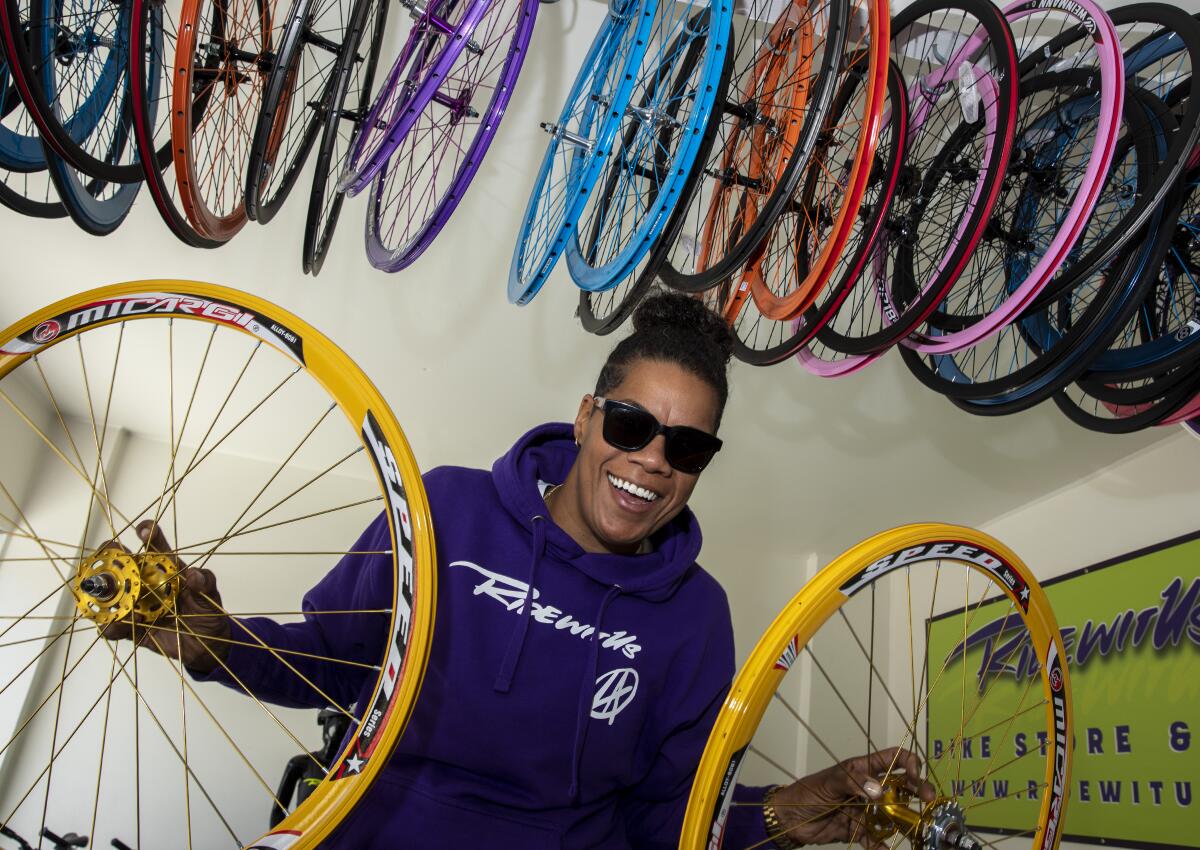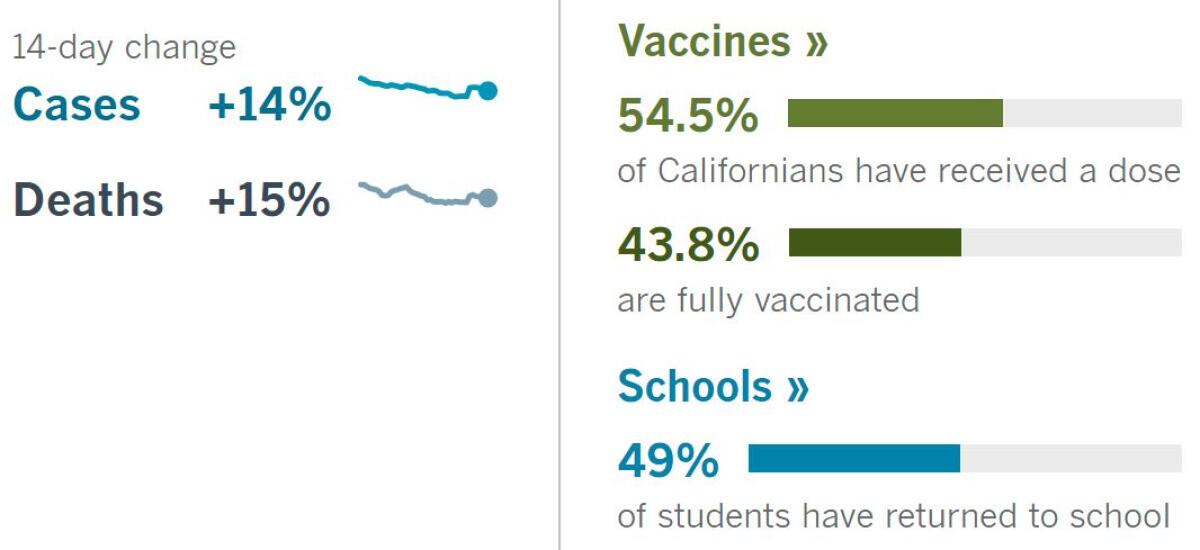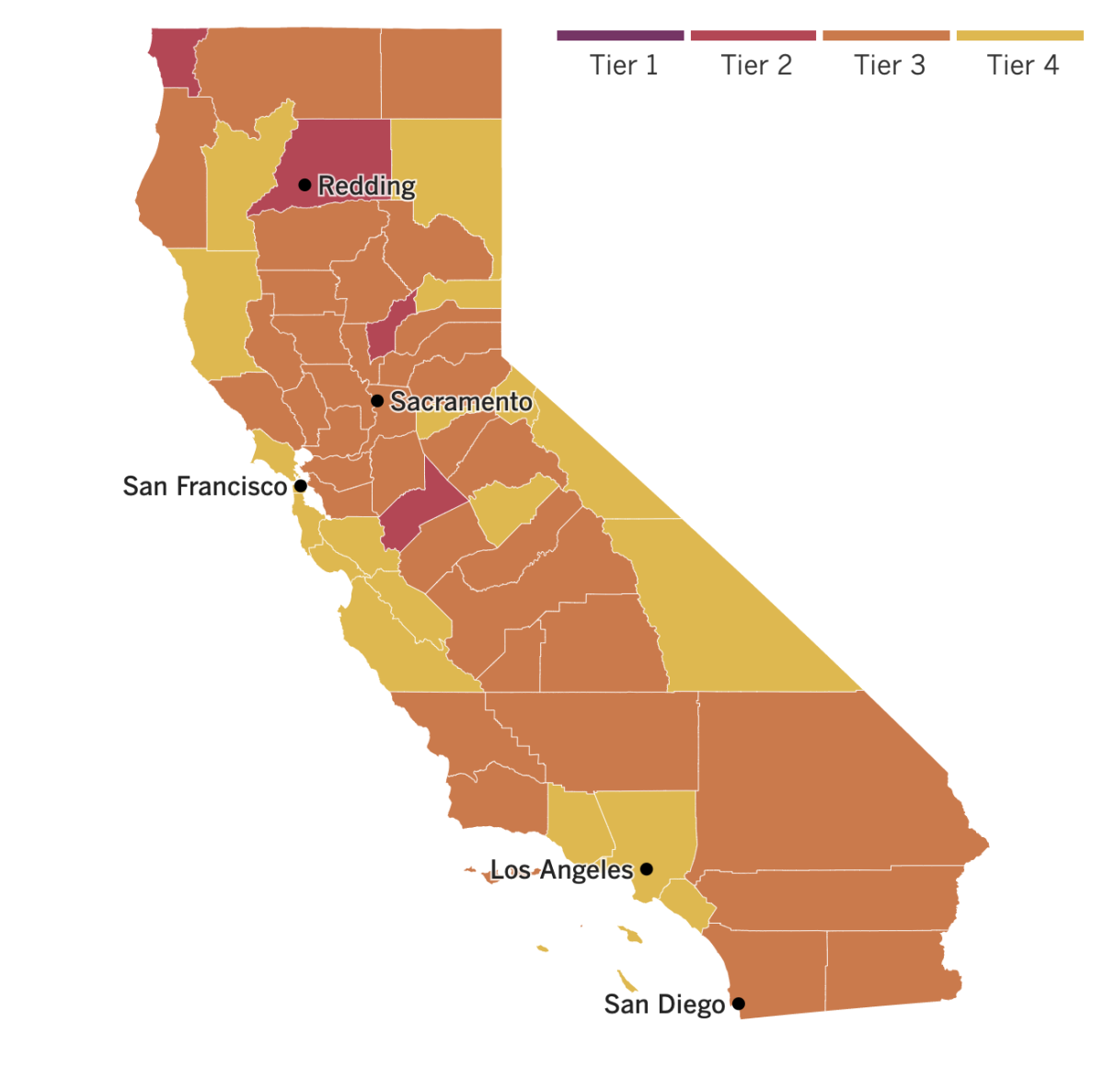Coronavirus Today: Pedals, pals and the pandemic
Good evening. I’m Russ Mitchell, and it’s Wednesday, June 2. Here’s what’s happening with the coronavirus in California and beyond.
I’ve been through a few fires here in the Bay Area, including the Oakland Hills firestorm of 1991, and I’ve hiked through the aftermath of several more that have blazed through Point Reyes National Seashore. Fortunately for me, my property was untouched by flames and no one I knew was seriously hurt, though others suffered mightily, losing their homes and in some cases family members and friends.
But life sprang back. In Oakland, it took the form of new houses and apartments. At Point Reyes, it was bright green shoots emerging from the charred ground, transforming over the years into rich new grasslands.
COVID-19 is kind of like that — a bringer of suffering and death that no one welcomed and no one would want to repeat. Yet for survivors, life goes on, offering opportunities for reflection, regeneration and perhaps a fresh outlook on life.
That positive side of tragedy is wonderfully expressed in this story by my colleague Donovan X. Ramsey about a woman and a bike club. It’s a story about adaptation, risk-taking, new beginnings, perseverance, teamwork and community.
Kellie Hart, 35, is a budding businesswoman in South L.A. She tried to open a car wash three years ago, but a con man made away with her $5,000 deposit. In April 2020, as the grim reality of the pandemic set in, Hart started riding a bicycle to relieve stress, inviting friends to come along. It was a safe way to exercise while maintaining social distance. The rides grew into a bike club, blossoming to about 150 riders — mostly Black and Latino people in their 30s and 40s — who gather three times a week for 12- to 25-mile rides.
The club took on the name RideWitUs, and in April, Hart opened a bike shop at Slauson near La Brea to pursue her deferred entrepreneurial dream. She knew it was risky, especially after the car wash ripoff — but “the greatest risks often yield the best rewards,” she said. “Scared money don’t make money.”
She started planting seeds, and the business grew from there. She used her savings to buy three bikes, and she sold them within 24 hours. The next day, she bought five bikes and immediately sold them too.

Now a new community has grown around the bike club and store, one that is intentionally inclusive. One club member, who said he was 30 pounds overweight when he went for his first ride, was amazed he never got left behind even though he could hardly keep up. “Everyone’s accepted. Everyone feels welcome,” said Reiichi Nickleberry, who has become a club leader. “You get a flat, it doesn’t matter. Someone’s gonna stop.”
Now Hart can’t imagine things any other way.
“In the beginning, I used to always say, ‘I won’t call it a movement until we can get 100 riders out on a Tuesday,’” she said. “By July 2020, we had our first Tuesday ride with more than 100 people. I only knew about 15 of those people prior to RideWitUs. I knew then it was something special, it was bigger than me, that these people needed it, and I can’t let up.”
By the numbers
California cases, deaths and vaccinations as of 5:56 p.m. Wednesday:

Track California’s coronavirus spread and vaccination efforts — including the latest numbers and how they break down — with our graphics.

Across California
RideWitUs isn’t the only local business that’s thriving — California’s economy is getting back in shape, too. Margot Roosevelt reports that the state’s strict public health measures set the stage for a faster recovery here than nationwide, according to a new UCLA forecast.
The state’s almost-always strong tech sector helped too. Plus, white-collar business sectors and a big boost in home building will help offset the slower return of tourist-dependent leisure and hospitality jobs, economists say.
In both California and the nation at large, “we are about to have one of the best years of economic growth that we’ve had since World War II,” said Leo Feler, senior economist for the UCLA Anderson Forecast. Pandemic stimulus and new government spending programs will make the recovery “euphoric,” he said.
Despite the optimism, UCLA experts warn of uncertainties for Californians, including the possibility that more residents will leave the state for regions with lower housing costs. (And, perhaps, to seek refuge from wildfires.)
Meantime, more counties are easing their COVID-19 restrictions, allowing more businesses to reopen and permitting already-open businesses to allow more employees and customers in. Four more counties — Marin, Monterey, San Benito and Ventura — moved into the least restrictive yellow tier this week. That makes 19 such counties that can allow most businesses to operate indoors with some safeguards.
Another four counties — Nevada, Sacramento, San Joaquin and Solano — also progressed Tuesday into the orange tier, the second-least restrictive tier on the reopening ladder.
Thirty-five of California’s 58 counties are now in the orange tier. Four remain in the more restrictive red tier, but none are in the strictest purple tier.
Don’t worry about keeping track of what the colors stand for. The tier system is set to be retired June 15, when the state reopens its economy. But fully reopened doesn’t necessarily translate into fully safe, especially in counties that have fallen behind in vaccinations and are seeing coronavirus cases rising.
Some rural counties in Northern California fit this description. For instance, only 27% of Tehama County residents have gotten a vaccine shot, according to data compiled by The Times, and the county has had California’s worst case rates over the last seven days, reporting about 20 new cases a day per 100,000 residents.
In Sacramento, California lawmakers are considering a bill that would force hospitals, clinics and skilled nursing facilities to pay medical professionals up to $10,000 in “hero pay” for their pandemic work. The bonuses would be paid out in four installments of $2,500 during 2022.
The Service Employees International Union California is a big supporter, arguing that the money will help persuade healthcare workers to stay on the job. Businesses that would be required to pay the bonuses — businesses in general, actually — don’t like the idea at all. They call it a job killer.
The state Assembly will vote on the measure this week. If it passes it will head to the Senate.


See the latest on California’s coronavirus closures and reopenings, and the metrics that inform them, with our tracker.
Consider subscribing to the Los Angeles Times
Your support helps us deliver the news that matters most. Become a subscriber.
Around the nation and the world
In many parts of the United States where the “Don’t Tread on Me” flag flies, the idea of a vaccine passport for travel is a non-starter.
In Europe, it’s a different story. Germany, Greece, Bulgaria, the Czech Republic, Denmark, Croatia and Poland have introduced what they call a COVID-19 “vaccination certificate” system. Greece, which depends heavily on tourism, has been pressing for a common vaccination certificate that uses a QR code with advanced security features.
The certificates, which are free of charge, are available to people who are fully vaccinated with EU-authorized COVID-19 shots as well as to those who have already contracted the coronavirus and developed antibodies and others who have had a negative PCR test within 72 hours before their arrival. They’ll be available in both digital and paper formats.
Officials hope the certificate program will make it easier for Europeans to visit other countries on the continent, and perhaps help kick-start a suffering tourist industry.
If you find yourself in Europe in coming days, don’t expect to bump into many Aussies.
Since March 2020, Australia has barred citizens and permanent residents from leaving the country except in “exceptional circumstances” when people can demonstrate a “compelling reason.” The ban was challenged in court, and this week the challenge was rejected, allowing the ban to remain in effect. Reportedly, hundreds of thousands of Australians are itching to get on a plane and spend some time elsewhere, though I can think of worse places to spend a pandemic.
Finally, scientists are becoming more optimistic that the world’s leading COVID-19 vaccines are doing their job well enough to diminish the need for frequent booster shots, though they caution that new coronavirus variants are a wild card.
Though studies are still underway, evidence is mounting that immunity from the mRNA vaccines made by Pfizer-BioNTech and Moderna does not depend exclusively on the antibodies that dwindle over time. The body has overlapping layers of protection that offer backup that could last a year or longer.
Pfizer and Moderna have estimated that people might need yearly shots, just like with flu vaccinations. Indeed, they’re already working to have some candidates ready this fall. But they’re not the ones that will decide when boosters get used — that will be up to health authorities in each country.
“I would be surprised if we actually needed a yearly booster shot,” said Dr. Paul Offit, a vaccine specialist at the Children’s Hospital of Philadelphia who advises the Food and Drug Administration.
Your questions answered
Today’s question comes from a reader who wants to know: How is emergency use authorization for a vaccine different from full FDA approval?
This is something that’s on the minds of many readers who wonder how the vetting process for COVID-19 vaccines differs from procedures used in non-pandemic times. If you’re worried about safety shortcuts, you can rest assured: Vaccine testing is rigorous whether it goes through the FDA’s normal approval procedures or gets emergency use authorization first.
New drugs and vaccines are tested in people through a three-step process. In Phase 1, researchers ensure that the medicine or vaccine is safe. In Phase 2, they test various dosages to determine the one that’s most effective. In Phase 3, that dose is tested against a placebo in a large group of people.
Normally, a company would wait until all the data from a Phase 3 clinical trial are in and analyzed by scientists before seeking FDA approval. But the emergency use authorization (or EUA) process was developed for public health emergencies, when time is of the essence. That means a company can seek authorization before the end of Phase 3 if the drug or vaccine performs well enough to meet a goal that was set before the trial began.
In order for a vaccine to receive emergency use authorization, “FDA must determine that the known and potential benefits outweigh the known and potential risks,” the agency explains.
The FDA also has to make sure that the vaccine can be produced safely and consistently. In the case of COVID-19 vaccines, manufacturers began making the vaccines while they were still being tested. It was a big financial risk — one the federal government paid for through Operation Warp Speed — but it resulted in shots going into people’s arms years earlier than they would have through the usual approval process.
As a result, the Pfizer-BioNTech, Moderna and Johnson & Johnson vaccines were authorized within months, with millions of doses ready to go. The companies are expected to seek full FDA approval when all of their Phase 3 clinical trial data are in. (Pfizer and BioNTech have already filed their application.) That’s important because EUAs expire when a public health emergency ends.
The COVID-19 pandemic presented a dramatic turn in the history of emergency use authorization. The process was created by Congress after the post-9/11 anthrax attacks. Before COVID-19, the FDA had issued fewer than 40 EUAs, mostly related to the Zika and Ebola outbreaks. Those have been eclipsed by the 344 EUAs issued to address COVID-19.
We want to hear from you. Email us your coronavirus questions, and we’ll do our best to answer them. Wondering if your question’s already been answered? Check out our archive here.
Resources
Need a vaccine? Sign up for email updates, and make an appointment where you live: City of Los Angeles | Los Angeles County | Kern County | Orange County | Riverside County | San Bernardino County | San Diego County | San Luis Obispo County | Santa Barbara County | Ventura County
Need more vaccine help? Talk to your healthcare provider. Call the state’s COVID-19 hotline at (833) 422-4255. And consult our county-by-county guides to getting vaccinated.
Practice social distancing using these tips, and wear a mask or two.
Watch for symptoms such as fever, cough, shortness of breath, chills, shaking with chills, muscle pain, headache, sore throat and loss of taste or smell. Here’s what to look for and when.
Need to get tested? Here’s where you can in L.A. County and around California.
Americans are hurting in many ways. We have advice for helping kids cope, resources for people experiencing domestic abuse and a newsletter to help you make ends meet.
We’ve answered hundreds of readers’ questions. Explore them in our archive here.
For our most up-to-date coverage, visit our homepage and our Health section, get our breaking news alerts, and follow us on Twitter and Instagram.




